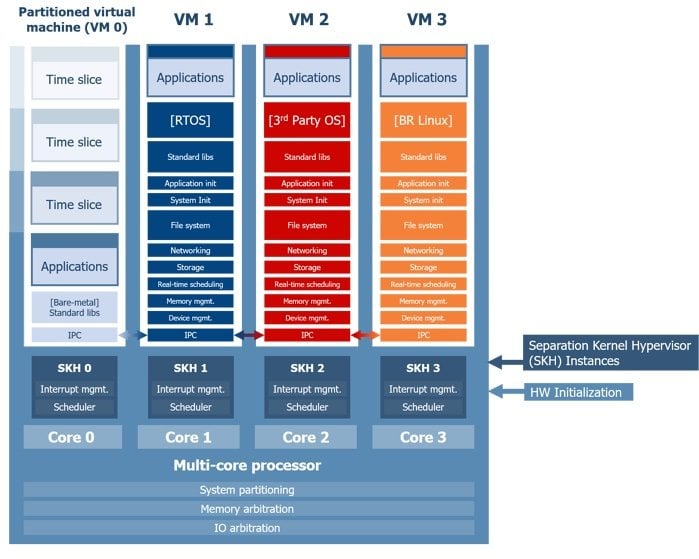Lynx Software Technologies adds new management capabilities to LYNX MOSA.ic
Enables more flexible management of multiple devices and systems from cloud or on-premise servers; provides air-gap between OT and IT networks.

Lynx Software Technologies (Lynx), the leader in delivering solutions for the Mission Critical Edge, today announced the delivery of new foundational capabilities to the LYNX MOSA.ic™ framework, which enable operators that manage critical information technology (IT) and operation technology (OT) infrastructure to flexibly deploy, monitor and manage multiple connected mission critical systems.
Use cases include factories, drones, energy infrastructure, planes, autonomous vehicles and secure infrastructure.
Lynx’s management model supports the ultimate flexibility for the IT and OT operators managing devices via on-premise, cloud or hybrid environments. This model gives companies that participate in avionics and defense, automotive, industrial and IT infrastructure markets the ability to combine the best of both worlds – embedded and edge – by bringing safety, security and real-time capabilities to the edge management paradigms and frameworks. Operators can now combine different management models on the same node.
As an example, a cloud managed workload, real-time control and local analytics can all run on the same system. As well as providing flexibility to operators, this new set of capabilities enables the creation of “systems of systems” mission critical infrastructure where critical air-gapping and data protection is implemented on each node. This separation is used to isolate and detach IT assets from OT assets, meaning OT and IT and cloud services can be used across a facility without affecting existing infrastructure.
In addition, end-points operating with sensitive and classified information can be deployed with isolated security functions and protected workloads, all the while automating complex tasks such as conditional boot-up.
Recent research by Lynx revealed many companies need to focus greater efforts on securely managing mission critical systems, as nearly one in five (19%) Americans in managerial and executive roles said their company has become less secure since the onset of the pandemic, and fewer than seven in 10 (69%) believe their company is ready to fend off an outside security threat.
“With the new LYNX MOSA.ic management capabilities, we’re effectively giving the mission critical operator complete control and flexibility over their systems,” said Pavan Singh, vice president of product management at Lynx Software Technologies. “Now every heterogeneous end user device or a compute node in a pipeline, a factory or a refinery can be treated as a collective set of isolated nodes with OT, IT and security workloads, managed from a diverse set of infrastructure options that avoid vendor lock-in.”
LYNX MOSA.ic is a framework that enables Lynx to combine its technologies with a growing ecosystem of technologies and tools from partners and the open source world. The new LYNX MOSA.ic updates will result in enhanced capabilities across the multiple industries Lynx supports with its systems: LYNX MOSA.ic for Avionics, LYNX MOSA.ic for Industrial and LynxSafe for enterprise IT environments.
The LynxSecure separation kernel hypervisor, a lean platform technology that controls hardware resources according to an intuitive information flow modeling language, continues to be the foundational element of the LYNX MOSA.ic framework. LynxSecure satisfies real-time, high assurance computing requirements used to regulate military and industrial computing environments, such as NIST, NSA Common Criteria, and NERC CIP.
Two new elements have been added to management libraries that run on top of LynxSecure:
Lynx Node Manager (LNM): Residing on the device (such as a gateway, a server blade or a drone), LNM includes management APIs, a Lynx Messaging Service and Elastic Compute. The capabilities enable a management controller to monitor, update and perform operation tasks on the system. This allows each mission critical node to be deployed, monitored and updated securely and safely without compromising the availability and performance
Lynx Management Center (LMC); Running either in the cloud or on-premise, LMC works with the Lynx Nodes to give the operator the system of systems view of their infrastructure. The technology can be, optionally, integrated with cloud-based management frameworks such as the Azure device twin. In addition, the combination of LMC and LNM is a great starting point for companies that prefer to leverage or develop their own management controller
“Adoption of virtualization and containerization is rapidly gaining steam at the mission critical edge,” said Chris Rommel, EVP at VDC Research. “Providing manageability and the separation kernel properties of workload isolation, security and hardware allocation will drive confidence in the industrial and critical infrastructure operators and ultimately accelerate digital transformation.”
The new enhancements enable a richer set of capabilities relevant to multiple industries and solutions providers:
- Avionics and Defense - Enables coordination across systems of various sizes to deliver advanced capability in the battlefield
- Enterprise IT - Provides highly secure systems (laptops and edge servers) that are not only built from the ground up to be tamper proof and immutable, but can also be continuously updated for security patches
- Cloud providers - Ensures providers can land their cloud services without having to worry about the hardware or implications to legacy systems
- Hardware providers - Opens the door to more strategic engagements by providing a complete offer for software and hardware and digital transformation
Following the integration of the new capabilities, other LYNX MOSA.ic features and benefits include:
- Lightweight - the same platform and framework can be used across a heterogenous combination of hardware systems including Arm- and Intel-based systems
- Completely open - gives multiple ways of reaching the same outcome, whether that’s a hardware provider starting with their hardware and packaging, LYNX MOSA.ic, Azure starting with Azure cloud services and offering LYNX MOSA.ic (Lynx is integrated with the Azure device twin) or system integrators starting with the platform and adjusting services in the customer settings
For more information about the LYNX MOSA.ic product visit the website.
www.lynx.com

